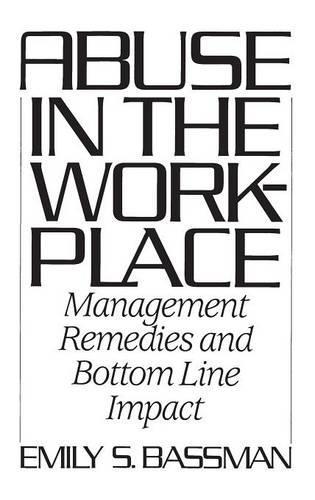
Abuse in the Workplace: Management Remedies and Bottom Line Impact
(Hardback)
Publishing Details
Abuse in the Workplace: Management Remedies and Bottom Line Impact
By (Author) Emily S. Bassman
Bloomsbury Publishing PLC
Praeger Publishers Inc
26th October 1992
United States
Classifications
Tertiary Education
Non Fiction
Sociology: work and labour
658.3
Physical Properties
Hardback
224
Description
This text identifies a major threat to the productivity, profitability and competitiveness of American business. This threat is the deteriorating relationship between managers and employees in the face of repeated downsizing, cost-cutting and demands to accomplish more with fewer resources. Stress brings out dysfunctional, abusive behaviour in managers, and a form of "generic harassment" results. The author creates a vision of the antithesis of an abusive environment - one that is empowering, where fair treatment is lived out in daily practices, where employees choose to exert discretionary effort, creating a peak performance culture. In creating this vision, the author applies principles from Total Quality Management to human relationships in the workplace, especially to those between managers and subordinates. The unique contribution is putting W.E. Deming's quality principles into behavioural terms based on psychology and learning theory. The author effectively documents that a transformation of how employees are treated is necessary, and not primarily to increase employee satisfaction. Rather, the primary reason to use these principles is to create the conditions whereby every employee can reach their full potential, thereby maximising their contribution to the business and achieving transformational, rather than incremental improvements in productivity. The author begins by mapping out the problem-defining and describing the various forms of abuse that surface in organisations, and clarifying how employee victims of abuse behave very similarly to victims of other forms of abuse. The unique elements of employee abuse are explained in terms of the nature of power in organisations. Why we persist in self-defeating, punishing interactions is explained with reference to principles of learning, and strategies are outlined for breaking the cycle of punishment and methods of negative behaviour control. The author then moves from a consideration of individual abusive relationships to institutional abuse. How employees are treated is positioned as an ethical issue, and related to aspects of corporate culture, policies and management practices. This leads into a discussion of the impact of employee abuse on organisations. The author documents the costs incurred by organisations that tolerate abuse, and describes some of the corporate programs that can be used to assess the extent to which employee abuse exists in the organisation. The last section of the book deals with solutions, offering guidance for senior management teams that choose to involve themselves in an assessment and cultural change effort.
Reviews
This book is an important contribution to the management literature because the author explains how abusive management of employees can impact negatively on the bottom line. The author alerts employers to the potential for this abuse, describes the conditions that foster it, and offers an approach for creating an empowering environment to minimize the probability that abusive behavior will occur.-Personnel Psychology
"This book is an important contribution to the management literature because the author explains how abusive management of employees can impact negatively on the bottom line. The author alerts employers to the potential for this abuse, describes the conditions that foster it, and offers an approach for creating an empowering environment to minimize the probability that abusive behavior will occur."-Personnel Psychology
Author Bio
EMILY S. BASSMAN is district manager with Pacific Bell in the area of Human Resource Planning. Before joining Pacific Bell, she spent ten years with AT&T, in various human resource and market research capacities. She is co-editor of Human Resource Forecasting and Strategy Development: Guidelines for Analyzing and Fulfilling Organizational Needs (Quorum, 1990).
